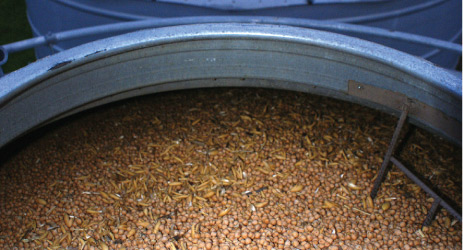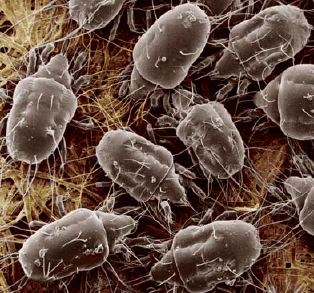Storing pulses successfully requires a balance between ideal harvest and storage conditions. Harvesting at 14 per cent moisture content captures grain quality and reduces mechanical damage to the seed but requires careful management to avoid deterioration during storage.
KEY POINTS
- Pulses stored above 12 per cent moisture content require aeration cooling to maintain quality.
- Meticulous hygiene and aeration cooling are the first lines of defence against pest incursion.
- Fumigation is the only option available to control pests in stored pulses, which requires a gas-tight, sealable storage.
- Avoiding mechanical damage to pulse seeds will maintain market quality, seed viability and be less attractive to insect pests.
Quality characteristics
Pulse crops most commonly grown in Australia include broad beans, faba beans, chickpeas, field peas, lentils, lupins, vetch and mungbeans.
Many of the quality characteristics of the grain from these crops are in the appearance, size and physical integrity of the seed. Mechanical seed damage, discolouration, disease, insect damage, split or small seeds will downgrade quality and market value.
Buyers prefer large, consistently-sized seed free of chemical residues for easy processing and marketing to consumers.
Optimum moisture and temperature
Research has shown that harvesting pulses at higher moisture content (up to 14 per cent) reduces field mould, mechanical damage to the seed, splitting and preserves seed viability. The challenge is to maintain this quality during storage as there is an increased risk of deterioration at these moisture levels. As a result, pulses stored above 12 per cent moisture content require aeration cooling to maintain quality.
Grain Trade Australia (GTA) sets a maximum moisture limit of 14 per cent for most pulses but bulk handlers may have receival requirements as low as 12 per cent. As a general rule of thumb, the higher the moisture content, the lower the temperature required to maintain seed quality (see Table 1).
Green pods and grains increase the risk of mould developing during storage — even at lower moisture content. Aeration cooling will help prevent mould and hot spots by creating uniform conditions throughout the grain bulk.
Weather damage hinders storage
Pulses exposed to weathering before harvest deteriorate more quickly in storage. Chickpeas stored for the medium to long term (6–12 months) continue to age and lose quality
(see Table 2). Growers can minimise the effects of seed darkening, declining germination and reduced seed vigour by:
- Lowering moisture content and temperature
- Harvesting before weather damages the grain.
Aeration cooling — vital tool
Aeration cooling:
- Creates uniform conditions throughout the grain bulk.
- Prevents moisture migration.
- Maintains seed viability (germination and vigour).
- Reduces mould growth.
- Lengthens (and in some instances stops) insect reproduction cycles.
- Slows seed coat darkening and quality loss.
Aeration cooling allows for longer-term storage of low-moisture grain by creating desirable conditions for the grain and undesirable conditions for mould and pests. Unlike aeration drying, aeration cooling can be achieved with air-flow rates of as little as 2–3 litres per second per tonne of grain.
High-moisture grain can also be safely held for a short time with aeration cooling before blending or drying. Run fans continuously to prevent self heating and quality damage.
Be aware that small seeds such as lentils will reduce the aeration fan capacity as there is less space for air to flow between the grains. For information on aeration cooling management, refer to the GRDC fact sheet, Aeration cooling for pest control.
Aeration drying
Pulses stored for longer than three months at high moisture content (>14 per cent) will require drying or blending to maintain seed quality. Aeration drying has a lower risk of cracking and damaging pulses, which can occur with hot-air dryers.
Unlike aeration cooling, drying requires high airflow rates of at least 15–25 l/s/t and careful management. For more information on aeration drying refer to the GRDC booklet, Aerating stored grain, cooling or drying for quality control.
Handle with care
In addition to harvesting at high moisture content, growers can manage seeds quality at harvest by:
- Minimising the number of times augers shift grain.
- Ensuring augers are full of grain and operated at slow speeds.
- Checking auger flight clearance — optimum clearance between flight and tube is half the grain size to minimise grain lodging and damage.
- Operating augers as close as possible to their optimal efficiency — usually an angle of 30 degrees.
- Using a belt conveyor instead of an auger where possible.
Silos fit the bill
 Silos are the ideal storage option for pulses, especially if they are cone based for easy out-loading with minimal seed damage. For anything more than short-term storage (3 months) aeration cooling and gas-tight sealable storage suitable for fumigation are essential features for best management quality control.
Silos are the ideal storage option for pulses, especially if they are cone based for easy out-loading with minimal seed damage. For anything more than short-term storage (3 months) aeration cooling and gas-tight sealable storage suitable for fumigation are essential features for best management quality control.
Always fill and empty silos from the centre holes. This is especially important with pulses because most have a high bulk density. Loading or out-loading off-centre will put uneven weight on the structure and cause it to collapse. Avoid storing lentils in silos with horizontally corrugated walls as the grain can run out from the bottom first and collapse the silo as the grain bulk slides down the silo walls.
Pests and control options
The most common pulse pests are the cowpea weevil (Callosobruchus spp.) and pea weevil (Bruchids pisorum). The cowpea weevil has a short life span of 10–12 days while the pea weevil only breeds one generation per year.
The only control options are phosphine, an alternative fumigant or controlled atmosphere, all of which require a gas-tight, sealable storage to control the insects at all life stages.
For more information refer to the GRDC booklet, Fumigating with phosphine, other fumigants and controlled atmospheres.
Chemical sprays are not registered for pulses in any State. While there is a maximum residue limit (MRL) for dichlorvos on lentils, the product is only registered for use on cereal grains.
Weevil development ceases at temperatures below 20°C. This is a strong incentive for aeration cooling, especially if gas-tight storage is not available.
Keep it clean
 The first line of defence against grain pests is before the pulses enter storage — meticulous grain hygiene. Because pest control options are limited, it’s critical to remove pests from the storage site before harvest.
The first line of defence against grain pests is before the pulses enter storage — meticulous grain hygiene. Because pest control options are limited, it’s critical to remove pests from the storage site before harvest.
Cleaning silos and storages thoroughly and removing spilt and leftover grain removes the feed source and harbour for insect pests.
Clean the following areas thoroughly:
- Empty silos and grain storages
- Augers and conveyers
- Harvesters
- Field and chaser bins
- Spilt grain around grain storages
- Leftover bags of grain
Chemicals used for structural treatments do not list the specific use before storing pulses on their labels and MRLs in pulses for those products are either extremely low or nil.
Using chemicals even as structural treatments risks exceeding the MRL so is not recommended.
Using diatomaceous earth (DE) as a structural treatment is possible but wash and dry the storage and equipment before using for pulses. This will ensure the DE doesn’t discolour the grain surface.
If unsure, check with the grain buyer before using any product that will come in contact with the stored grain. For more information see the GRDC fact sheet, Hygiene and structural treatments for grain storages.


